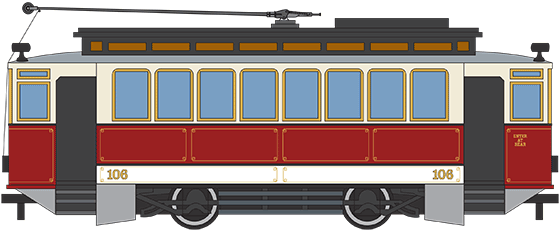One of the oddest legacies of the twilight of the Cold War has to be this streetcar. It comes from perhaps the tramway capital of the world – the old Union of Soviet Socialist Republics.
Car 106 is typical of early European streetcars (known as trams outside North America). Short, with open platforms at each end, and designed to tow trailers to make up for the small capacity of the vehicle itself. (No trailer came with Car 106). This tram was one of thousands built to serve Soviet cities in the early electric era. It rides on an unusual single truck, hinged in the middle – the same concept as Muni’s 1922-built “dinkies” that ran on the original E line between the Ferry Building and the Presidio.
This vehicle was built for use in Moscow, and was said to have carried wounded soldiers to hospitals when the Germans were at Moscow’s doorstep during World War II. It continued to serve Moscow until 1960 and was then assigned to Orel until 1978, racking up 1.75 million total miles of passenger service before being modified into a work car. After finishing that duty, it was cosmetically restored as a historical exhibit in Orel.

While this model of tram was designed in 1912, when Czar Nicholas still reigned in Moscow, the documentation provided by the Soviets when it arrived in San Francisco claimed this particular tram was built in 1922. (A cynic at the time observed that the Soviets wouldn’t have been able to present it as a gift if they acknowledged it had actually been built before the 1917 Revolution.)
Whatever its birth date, that’s how it came to San Francisco – as a gift.
With the growing popularity of the Historic Trolley Festivals on Market Street as the 1980s progressed, the late Maurice Klebolt, a colorful character (and longtime Market Street Railway director) teamed with fellow MSR director Rick Laubscher to bring a Soviet car to San Francisco. Klebolt lobbied the Soviet Consul General of the time, Valentin Kamenev, hitting on the idea of making the gift of an antique Soviet tram for San Francisco’s Trolley Festivals an act of glasnost, or rapprochement with the United States. After lots of convincing, the idea took hold, and the Soviets selected the Orel tram, dubbing it “Streetcar Named Desire for Peace.” Be sure you read the wonderful story of its acquisition.
Car #106 was presented to Mayor Dianne Feinstein by Consul General Kamenev in a Market Street ceremony January 28, 1987. A news account at the time noted that a Soviet Foreign Ministry spokesman in Russia, asked about the gift, commented “We can also sell refrigerators to Eskimos and carry coal to Newcastle.” Clearly, car #106 helped warm the Cold War, even if only a tiny amount. There was much conviviality on both sides of the transaction, and the car was extremely popular when it operated in the 1987 Trolley Festival.
Then, however, with service suspended while the F-line was being built, the car ran afoul of the elements. Lack of covered storage at Muni’s Geneva Division proved costly, as serious rust damage and rot set in. It did manage to make it out in 1992 to participate in the parade of streetcars up Market Street to mark San Francisco’s streetcar centennial. Market Street Railway volunteers at our Mint Division facility worked on keeping the ravages of time from getting worse, but because it was not accessible to disabled riders due to narrow doors (which would require major rebuilding to remedy), and because of its small size (seating capacity of just 24), the “Streetcar Named Desire for Peace” has not been a priority for restoration. At least it is now under cover, at Muni’s Cameron Beach Yard, hopeful for a future return to service.
The Soviet Union went on to build thousands of trams modeled after American PCCs, built mostly by Tatra in the old Czechoslovakia when it was part of the Soviet Empire. We would have to have an example of these well-built trams, but California’s Public Utilities Commission now has rules barring bringing in additional streetcars built after 1955 unless they meet strict, unfeasible specifications. Only a handful of Tatra T-class trams before that date survive, all happy in European museums.
As for streetcar diplomacy improving relationships between the US and Russia? Well, things happened.
Originally Built For
Moscow tramways, Russia
Acquired by Muni From
Consulate General of the Soviet Union, 1987
Year Built
1912 (?)
Builder
Colona Iron Works
Seats
24
Length
33’9″
Width
8′
Height
10′ 5″
Motors
2 35 HP
Control
Hand controller
Trucks
Single truck, hinged
Brakes
Dynamic, air, hand
